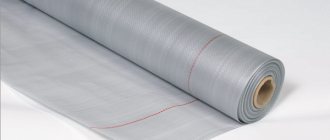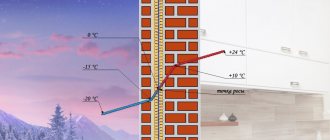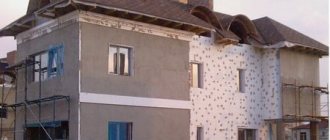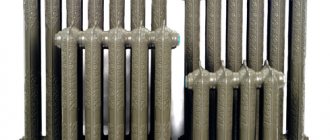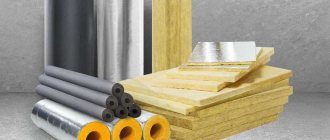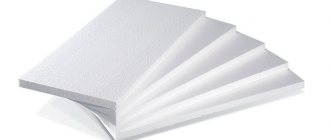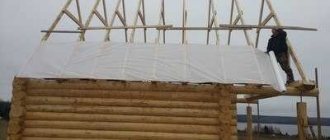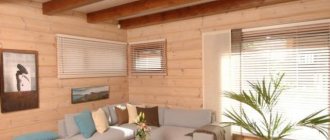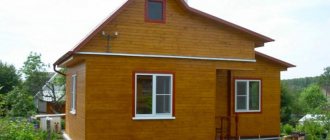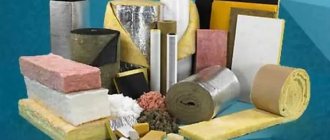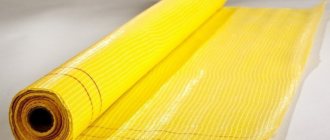The protection of the insulation layer in the roofing pie is carried out by two types of insulating materials, different in structure and purpose. Their illiterate use, incorrect selection according to technical parameters, and incorrect installation lead to the thermal insulation getting wet and to the loss of the qualities specified by the manufacturer. As a result, instead of reducing heat loss, wet insulation will increase leaks; rooms equipped in this way will be excessively damp and cold.
To avoid the described negative, let’s find out how vapor barrier differs from waterproofing, and how a roof insulation system is constructed using these protective films.
Subtleties of constructing a roofing pie
The pie of an insulated roofing system is a multi-layer structure, each component of which must flawlessly perform the work entrusted to it. Its main component is represented by insulation, to protect it from getting wet, insulating films are installed above and below, and ventilation ducts are installed.
The upper and lower protective layers of roofing thermal insulation perform different jobs:
- A barrier laid on top protects the thermal insulation from atmospheric water that falls in the form of liquid precipitation and is formed when snow deposits melt. This layer is called waterproofing; it prevents moisture from penetrating from the outside of the insulation system, but does not prevent moisture from penetrating from the inside from freely leaving the insulation.
- The insulation installed at the bottom protects the insulation from household fumes generated during the operation of the premises, during cooking, hygiene procedures, etc. This is a vapor barrier designed to prevent steam from entering the thermal insulation thickness.
The vapor barrier does not allow vapor to pass through at all or only at a minimum. For its functional purpose, waterproofing must conduct vapor water coming from below. Hence the difference in structure and the differences in the work performed by the materials.
Does your roof need protection?
Let's start with the roof. When building a house, this structural element is given paramount importance. Because it primarily resists the effects of various natural elements: heavy precipitation in the form of rain, snow, hail, hurricane gusts of wind (wind protection), and also protects the house from the scorching rays of the sun. Both materials have wind protection. The roof guards our comfort and convenience.
In addition to protecting against external influences, the roof also prevents heat from escaping from the house to the outside. After all, it is very well known that warm air currents always tend upward, so it is always necessary to install insulation on roofs in order to retain internal heat and prevent external cold from penetrating into the premises. But in order for the insulation to last as long as possible and not lose its commercial qualities, it must be protected from any exposure to moisture, both in the form of water and steam.
The materials themselves, from which the roof is constructed, of course, do not allow moisture to pass through and protect the insulation from getting wet, but they are not able to protect it from the effects of water vapor. To do this, it is necessary to carry out waterproofing measures that will protect the insulation from excess moisture.
Some builders, in order to save money or due to lack of knowledge, do not waterproof the insulation installed under the roof. Very often, cheap materials are purchased, and some even use ordinary plastic film for greenhouses , others prefer to use materials that protect only from steam, without betraying the fact that these are completely different products with different properties.
As a result, within a short period of time from installing the attic roof and insulation with improper waterproofing, water suddenly begins to drip, and the ceiling becomes covered with stains. In this case, most often the roofing surface is thoroughly checked for damage, but not finding any, many wonder what was done wrong.
The explanation in this case is quite simple: if instead of a waterproofing film a vapor barrier was installed, then as a result the insulation has completely absorbed moisture and creates streaks and “rain” in the room. It is much worse if waterproofing was not carried out at all, then in this case the insulation filled with moisture causes harm to the rafters, the wooden sheathing and even the entire roof structure, thereby damaging the interior decoration of the premises.
Vapor permeability as the main indicator
Vapor permeability is one of the main characteristics of insulating roofing films, which influences the selection and determination of the location for their installation. It is indicated by material manufacturers in the technical documentation, indicated in grams or fractions of a gram, which 1 m2 of roll insulation can carry out per day (mg/m2 per day).
Based on the ability of protective materials to transmit steam, they are divided into two main classes:
- Vapor permeable. Includes all types of waterproofing membranes. The ability to conduct steam amounts to hundreds and even thousands of milligrams.
- Vapor-tight. Includes polypropylene and polyethylene films, anti-condensation membranes. Their ability to pass steam is equal to fractions of a milligram, several units or tens of milligrams.
According to construction regulations, the components of the roofing pie are selected so that their ability to transmit vapors increases from the inside to the outside. Those. The bottom film should have the lowest vapor permeability indicators.
The insulation should be more capable of transmitting steam than the vapor barrier, but it should be less than that of the waterproofing. The described structure of the roofing pie is necessary so that all moisture that may end up in the thickness of the thermal insulation does not linger there and is freely removed outside the roofing system.
In a well-designed pie, everything that managed to break through the vapor barrier barrier rushed through the insulation to the waterproofing, which freely allows steam to pass outside the structure, but prevents raindrops and melt water from penetrating into the thermal insulation.
A similar principle is observed when arranging partitions and ceilings installed between rooms with different operating conditions. Simply put, a thermal insulation system should be installed between the heated rooms and the cold attic, with a vapor barrier deployed towards the housing.
If, within the same floor, a room with standard operating conditions is adjacent, for example, to the steam room of a Russian bath, then a partition between them is insulated by installing a vapor barrier film first from the steam room.
However, for the flawless organization of a roofing system, it is not enough to divide materials into classes according to their ability to prevent or easily release steam. It is imperative to find out what materials are used as under-floor films, what is the difference between the methods of installing vapor barriers and waterproofing, and how the technology for laying them is implemented.
Types of modern vapor barrier materials
Modern vapor barrier film for roofing is a multilayer material with limited or almost zero diffusion properties.
Note!Of course, you can use regular high-density polyethylene film. But given the low resistance to mechanical damage, it is not even recommended to use it when installing a vapor barrier for the floor. And on the roof, the degree of “responsibility” of this layer of the roofing pie is even higher.
The simplest version of the film contains two layers, one of which has an anti-condensation surface.
The anti-condensation surface has a “rough” appearance and is turned into the attic
Reinforced films also have a reinforcing layer in their structure - a mesh of durable polypropylene threads. This type of vapor barrier belongs to the Standard category. For example, the Utah company offers a special type of vapor barrier, Yutafol Special, with improved fireproof properties, which, as a third layer, does not contain a reinforcing mesh, but a self-extinguishing reagent.
And the last option is three- and four-layer films with a heat-reflecting surface. In this case, the vapor barrier receives another additional function - energy saving.
Types of vapor-tight options and their characteristics
Previously, the only vapor barrier option was glassine, which transmits on average about a hundred mg/m² per day. To construct a vapor barrier from it, the roofer needed to show miracles of dexterity, because... the material was easily damaged during installation. There was a problem when connecting glassine strips into a single canvas and when wrapping structures of complex shapes.
Glassine was replaced by polyethylene, and later polypropylene, or more precisely, a film made from it, was introduced into the vapor barrier sphere. They became the basis for the development of an extensive line of polymer membranes used in vapor and waterproofing. The new generation of insulating materials is ahead of its predecessors in strength indicators, resistance to UV and unstable temperatures.
The list of polymer vapor barrier types includes:
- Foil membranes . Materials with a metal shell located on the working side. They are used in the arrangement of hygienic premises that require maintaining the temperature obtained during heating: saunas, steam rooms. The foil surface can serve as a reflector of heat waves if a gap without ventilation is left between it and the casing.
- Anti-condensation films . Rolled materials, one side of which has a rough texture, the other - smooth. A rough surface prevents the formation of dew on the vapor barrier; a smooth surface prevents the reverse flow of moisture that has penetrated or formed in the insulation.
- Films made of polypropylene and polyethylene . Most often these are reinforced analogues of outdated polyethylene and polypropylene options. They are used in budget construction, although at a price per 1 m2 they are not too different from new polymer vapor barrier materials.
Vapor barrier materials with a vapor permeability of several tens of mg per 1 m2 per day are still used to this day in thermal insulation systems for cold attics, insulated with backfill material, for example, expanded clay. If there are real restrictions on the construction budget, then this type can be used in the arrangement of heated attics.
However, the difference between the cost of polyethylene with propylene and membrane barriers is such that there is little point in such savings. In addition, new types of vapor barrier protection are much stronger and are difficult to damage due to careless movements during installation. Anti-condensation membranes last almost as long as roofing coverings, i.e. During the entire operation of the roof, there will be no need to carry out major repairs.
Structure of vapor barrier films
Vapor barrier differs from waterproofing mainly in that both its sides are completely waterproof. Vapor barrier should not allow either steam or water to pass through either outside (into the house) or inside the insulation.
A cheap option for such film is ordinary polyethylene. However, it is not recommended to use it as a vapor barrier for a roofing “pie” due to the fact that under the roof, especially in summer, the film will become very hot, which will lead to its stretching and, possibly, damage. And since we are covering the roof for more than one year, it is optimal to use a film made of several layers with a polymer reinforcing frame that prevents the film from stretching.
Covering the inner surface of the attic roof with a film covered with foil on one side will cost slightly more than using various types of vapor barrier materials, however, in addition to creating a reliable vapor-tight barrier, it will also be possible to retain heat in the house. Installation of this film is carried out with a foil surface inside the room, which helps to reflect infrared radiation from it, with which the main share of heat evaporates from the home. Thus, the use of such a vapor barrier allows you to kill two birds with one stone, reducing heat loss through the roof of the house to a minimum, which in turn will allow you to save quite a lot on heating.
Before purchasing any film, be sure to make sure that it is a vapor barrier, as indicated by the inscription on the packaging.
Properties and types of vapor-permeable membranes
The main difference between polymer membranes for waterproofing and materials for vapor barrier is that they freely allow steam and condensation formed in the thickness of the insulation to pass out due to the difference in temperature values under and above the insulation system. A material has not yet been invented that can prevent the appearance of moisture in thermal insulation. However, there are technologies that allow you to get rid of water in the roofing pie, and materials for implementing such schemes.
As already mentioned, waterproofing is placed on top of the insulation. It is located under the roof. Between it and the heat-insulating layer, a ventilation gap is arranged or not, depending on the material used in organizing the system.
Types of vapor-permeable, otherwise called vapor-transparent, materials in demand in construction include:
- Perforated films . Rolled materials with specially shaped holes that allow steam to escape but do not allow water to pass through from the outside. They serve mainly as insulation for slopes above cold attics, because... cannot fully perform waterproofing and windproof functions.
- Porous membranes . Materials with a fibrous structure, similar in structure to a filter. The vapor permeability indicators of this type depend on the pore diameter and the ability of the fibrous fabric to transmit evaporation. This type of waterproofing is not used where there is a possibility of clogging of pores due to excess dust.
- Superdiffusion membranes . The thinnest multilayer membrane systems, each layer of which performs a specific job. There are no holes in their structure that can become clogged with dust, therefore the materials of this group have the highest resistance to all kinds of contamination.
Superdiffuse membrane insulation comes in two and three layers. Two-layer varieties are inferior to three-layer counterparts in terms of strength criteria, because in their structure, one of the reinforcing substrates has been removed. In terms of cost, both options are not too different, therefore, if possible, it is better to choose a three-layer material.
Porous and super-diffusive materials, together with waterproofing duties, play the role of wind protection. They prevent winds from “washing out” heat from lightweight fibrous cotton insulation. Perforated films do not do this job, therefore, when using mineral wool to insulate slopes, they require the installation of an additional windproof carpet, which sometimes reduces the initial savings to zero.
The installation of under-roof waterproofing is necessarily accompanied by the installation of a ventilation system, which can be:
- Single-level . Predetermining the organization of ventilation ducts, vents, between the waterproofing barrier and the roofing. It is installed using superdiffusion and porous membranes, which are not prohibited from coming into close contact with any type of insulation.
- Two-level . Assuming the organization of two levels of ventilation. channels located between the thermal insulation and the hydraulic barrier, then between it and the coating. the scheme is typical when using perforated films
Vents - ventilation ducts located parallel to the pitched roof are installed by installing a wooden batten with a wall height of at least 4 cm. For a two-level system, the river is fixed in two tiers: above the insulation and above the waterproofing. The lathing formed with its help at the same time fixes the roll insulation, and also serves as the basis for laying the roof or continuous flooring for soft types of coverings.
Purpose of waterproofing
The main task of the waterproofing layer is to prevent water from entering the building envelope (from the street, groundwater, indoor water leakage). Let's look at application examples:
- The enclosing structure is a roofing pie. In this case, the main waterproofing layer, providing protection from direct ingress of precipitation, is the roofing material (slate, metal tiles, etc.). Next comes additional protection from moisture. For example, a layer of waterproofing film or membrane.
- Basement, ground floor. To maintain an optimal microclimate and protect against moisture, it is necessary to create a barrier between the structure and the soil in contact with it. By treating the outer surface with special waterproofing compounds or weld-on materials, you can protect yourself from the effects of groundwater.
- Interior areas in contact with water. These include the kitchen, bathroom, toilet. Unlike basements, where they struggle with moisture from the outside, in this case, using waterproofing materials, they try to prevent unwanted water from entering other rooms.
The nuances of laying roofing films
We found out that waterproofing materials that protect the cake from atmospheric negativity can be installed with one or two ventilation gaps. They are needed so that moisture does not accumulate in the multi-layer roofing system, but is freely removed by air flow through the vents formed by the slats.
An equivalent function is performed by the ventilation gaps that accompany the laying of vapor barrier films. Regardless of the structure and composition of the material, they are installed with two tiers of ventilation located on both sides of the vapor barrier. Due to low vapor permeability, this layer requires increased ventilation.
Most roofing films do not have the ability to stretch when tensioned. Therefore, they are laid on the rafter frame so that the rolled insulation sag somewhat in the space between the rafters. The sagging is necessary to prevent the material from cracking under tension during standard movements typical of wooden systems.
Waterproofing sheets are laid out depending on the steepness of the structure. On steep roofs, the material is placed along the rafters; on flat roofs, it is placed parallel to the ridge girder. Vapor barrier strips are installed exclusively parallel to the ridge.
The strips are laid with an overlap, the amount of which is indicated by the manufacturer of the insulating products. The side on which the strips should be installed must be indicated on the rolls. Changing sides is strictly prohibited, because As a result, the vapor and water insulation properties will change.
When installing waterproofing, laid parallel to the ridge rib, they start from the eaves line. For proper installation, the edge of the starting waterproofing strip should protrude beyond the edge of the cornice by a minimum of 10 cm. It is then brought out under a drip line or a cornice strip. The strips are laid so that the overlap of the upper panel overlaps the edge of the lower one.
The construction of a vapor barrier begins, starting from the ridge ridge. Each subsequent panel must overlap the edge of the previous one. If you follow the described method in installing both types of insulation, a minimum of water gets into the insulation.
Installation features
After installing the rafter system, the waterproofing is attached, then the roof sheathing and the roof itself. Insulation is placed between the rafters, and laying a vapor barrier on the roof is the penultimate stage of its arrangement. Next comes the interior lining (finishing) of the attic space.
To create a continuous sealed vapor-tight layer, the film is installed from the bottom up with an overlap of adjacent panels by at least 15 cm. The same principle is followed if it is necessary to increase the length of the panel. Attach the film to the rafters (or sheathing) with a stapler or wide-headed nails.
Joints and interfaces with adjacent surfaces are additionally sealed with sealed vapor barrier tape. To do this, use a tape 10-25 mm wide with a butyl rubber or acrylate double-sided self-adhesive layer.
The Ondulin company produces a vapor barrier film that already has a self-adhesive layer located from the edge of the panel at an overlap distance
First, remove the anti-adhesive paper from one side and apply it to the bottom vapor barrier strip. Then, overlap the bottom strip with the top strip of vapor-proof film, remove the anti-adhesive paper from the other side of the tape and press the strips together. When gluing the roof vapor barrier to adjacent fences and structures (made of concrete, brick, metal or plastic), their surfaces must be cleaned of dust and dirt.
The final fixation of the vapor barrier to the rafters or to the sheathing of the internal cladding is carried out using wooden slats or a metal profile.
For the “proper operation” of the anti-condensation or reflective surface, a gap is required between the vapor barrier film and the finishing cladding. If the finishing is done with wall panels, then a lath with a section height of 4-5 cm is used for the sheathing.
A batten or board over a vapor barrier also serves as sheathing for the interior lining of a residential attic.
When covering an insulated attic with plasterboard, the gap size is set using direct suspension (the height of the side of the CD ceiling profile is insufficient - only 28 mm).
From the video you can learn about installing a vapor barrier:
This may be interesting! In the article at the following link, read about the modern “House of the Earth”.
Types of vapor barrier
- ordinary polyethylene;
- membrane insulation;
- reinforced polyethylene;
- foil vapor barrier (reflective);
- liquid rubber;
- sackcloth.
Ordinary polyethylene
Polyethylene film is the simplest material intended for vapor barrier. Today, perforated and non-perforated films are available for sale.
For vapor barrier, non-perforated films are usually used. The advantage of the product is its low price. Disadvantages - short service life.
Reinforced polyethylene
Polyethylene, reinforced with twisted polymer thread, is used for vapor barrier of one part - floor, ceiling or walls, because when finishing the entire apartment there will be a thermos effect.
Membrane insulation
Diffuse membranes are a material designed to reliably protect heat-insulating raw materials from steam.
Single- and double-sided products are available.
The first conducts steam in one direction and it is important not to confuse which side to lay towards the insulation.
The second acts in two directions, so it is attached to the thermal insulation on either side.
Single and multilayer membranes are available. Advantages: durability, wear resistance, environmental friendliness and functionality. The disadvantage is the high price.
Foil insulation
Reflective foil vapor barrier is a universal raw material that plays the role of steam, hydro, sound, and thermal insulation, reflecting heat due to the foil. It is also an ideal material for protecting insulation in a bathhouse or sauna, because... not afraid of high temperatures and humidity.
It is fastened using a regular furniture stapler, and the joints are glued with metallized tape. A typical example of a vapor barrier for a bathhouse is penotherm. Advantages: long service life, versatility, excellent resistance to high temperatures, environmental friendliness. The disadvantage is the high price.
Liquid vapor barrier
This type (also called liquid rubber) is more related to waterproofing materials, but it also copes with the function of protection against steam. It is a special solution of polymers that is applied to the surface in a liquid state. Use a regular paint brush or roller for this.
After drying, a dense vapor-proof film is formed. It insulates sound and heat well. In bathhouses, this option is relevant for concrete floors in the sink. Concrete is relatively warm and at the same time not affected by water. This is the method used to waterproof pools.
Sackcloth
Burlap is a raw material designed to protect thermal insulation material. Its base is film-type polypropylene threads. They are laminated with low-density polyethylene. The layer thickness reaches 20 microns. Advantage – low price. The disadvantage is the formation of microcracks.
What do errors in terms lead to?
Manufacturers' marketers are interested in increasing sales of vapor barrier films and waterproof vapor-permeable membranes. They advertise their properties in every possible way, coming up with various names. Thus, the complex word vapor-waterproofing was created, which led to confusion of the characteristics of two completely different materials used to solve opposing problems.
Due to this, building owners can allow the installation of vapor barriers on both sides of the wall structure, when moisture cannot escape from the building elements and will create increased dampness and their destruction.
An even worse situation with moisture occurs when the location of the vapor barrier, which was installed outside the wall, is confused with the vapor-permeable membrane installed inside the room.
Then all the moisture from the room is directed into the wall, and its exit is blocked. As a result, mold, fungi, and dirt form.
The installation of protective film coverings must not be interchanged. They perform different, opposing functions.
Let's summarize the use of film materials for the home craftsman:
- In cold climates, the vapor barrier membrane is placed exclusively from the inside of the room, regardless of the type of building structure - wall or roof.
- In order for the vapor barrier to work effectively, it must be made as airtight as possible, using a construction type of tape with a butyl rubber base of glue, which effectively glues the film for the entire period of operation.
- An ordinary polyethylene film 200 microns thick works optimally as a vapor barrier. It is a good alternative to advertised “brand” models.
- The installation location for vapor-permeable superdiffusion membranes is the outside of the building.
- Before installing the membrane, it is necessary to clarify the distance of its location from the surface to be protected: close or at a distance. You can find out this in the instructions that manufacturers put in a roll of film and post on their website, and it is better to double-check the seller’s recommendations.
- The quality of vapor-permeable membranes is higher from well-known manufacturers from Europe and America.
To better understand the topic of vapor barrier and the role of vapor-permeable membranes that create waterproofing, we recommend watching a video by the owner of ASC Group.
Regardless of where they live, every person wants to live in comfort and coziness. However, in order to create a favorable atmosphere at home, you need to think through all the nuances. For example, in Russia there are very harsh winters and therefore, first of all, you need to think about high-quality insulation, which will help you save on heating costs in the winter. In this case, waterproofing and vapor barrier is an excellent option to solve the problem.
Nowadays you can find many options for film coatings in stores, so it is difficult for an inexperienced person to choose the optimal material. For example, waterproofing components prevent liquids from entering a room. At first it may seem like a waste of time, although over time you begin to understand the need for additional protection. This type of roof is needed when there is a layer of insulation. The fact is that the additional filling cannot completely retain all precipitation (snow, rain) and moisture gradually gets into the mineral wool. In this regard, the thermal insulation properties disappear and the structure deteriorates. Putting all the facts together, we can say that waterproofing is simply necessary.
Purpose of films in roofs and walls
Vapor-permeable membranes allow steam to pass in both directions. But, nature so decreed that it always goes along with the flow of air from the warm side to the cold side.
Considering the characteristics of our harsh climate and the length of the heating season in residential premises, we can confidently assume that steam most often leaves the rooms on the street, rather than enters them.
At the same time, the pattern of steam movement through walls, floors, ceilings, doors and other building elements depends on the materials and methods of manufacturing these structures. Let's take a closer look at them.
How vapor diffusion occurs through a single-layer structure
Using the example of a homogeneous wall of a house, it can be argued that the penetration of steam from a warm apartment into the cold outside air of the surrounding atmosphere proceeds equally, evenly. Even in construction descriptions, one can often find an allegory for this phenomenon, when the authors write that the walls of wooden houses “breathe,” using a collective image to describe the processes taking place.
A wall made of any homogeneous building material: wood, brick, concrete, stone, aerated concrete, created in one layer, does not create obstacles to the diffusion of steam. When a structural element has several components, the vapor permeation pattern changes.
How does vapor diffusion occur through a multilayer structure?
In a wall consisting of several building layers, the vapor permeability increases as it moves towards the cold.
This explains the fact that steam comes out of each successive layer of the wall faster than from the previous one. Therefore, an area of saturated steam does not appear inside a multilayer wall, when it is able to condense and fall out as real moisture - water, forming.
However, this purely theoretical explanation is very difficult to implement in practice for a number of technical reasons.
